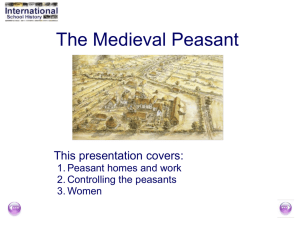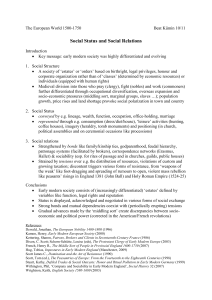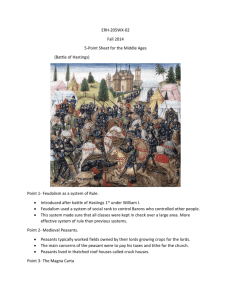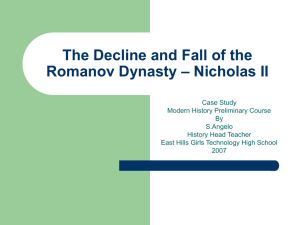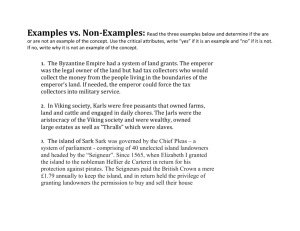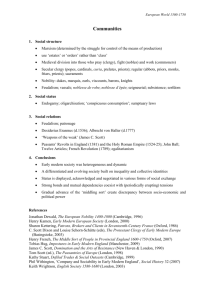File
advertisement
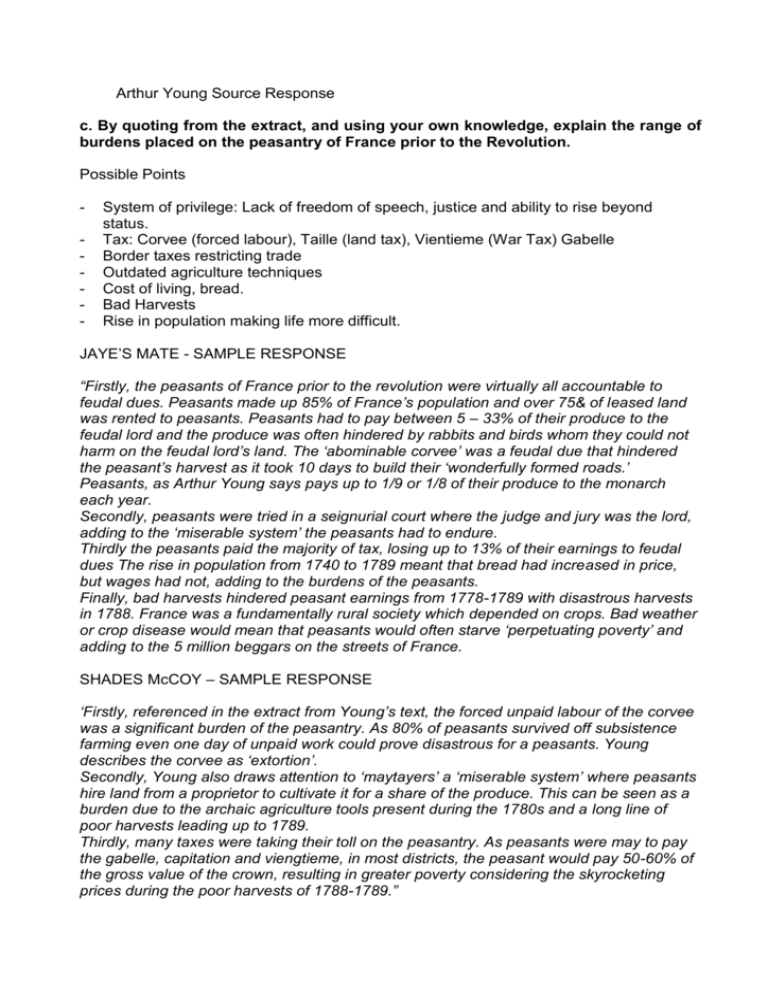
Arthur Young Source Response c. By quoting from the extract, and using your own knowledge, explain the range of burdens placed on the peasantry of France prior to the Revolution. Possible Points - System of privilege: Lack of freedom of speech, justice and ability to rise beyond status. Tax: Corvee (forced labour), Taille (land tax), Vientieme (War Tax) Gabelle Border taxes restricting trade Outdated agriculture techniques Cost of living, bread. Bad Harvests Rise in population making life more difficult. JAYE’S MATE - SAMPLE RESPONSE “Firstly, the peasants of France prior to the revolution were virtually all accountable to feudal dues. Peasants made up 85% of France’s population and over 75& of leased land was rented to peasants. Peasants had to pay between 5 – 33% of their produce to the feudal lord and the produce was often hindered by rabbits and birds whom they could not harm on the feudal lord’s land. The ‘abominable corvee’ was a feudal due that hindered the peasant’s harvest as it took 10 days to build their ‘wonderfully formed roads.’ Peasants, as Arthur Young says pays up to 1/9 or 1/8 of their produce to the monarch each year. Secondly, peasants were tried in a seignurial court where the judge and jury was the lord, adding to the ‘miserable system’ the peasants had to endure. Thirdly the peasants paid the majority of tax, losing up to 13% of their earnings to feudal dues The rise in population from 1740 to 1789 meant that bread had increased in price, but wages had not, adding to the burdens of the peasants. Finally, bad harvests hindered peasant earnings from 1778-1789 with disastrous harvests in 1788. France was a fundamentally rural society which depended on crops. Bad weather or crop disease would mean that peasants would often starve ‘perpetuating poverty’ and adding to the 5 million beggars on the streets of France. SHADES McCOY – SAMPLE RESPONSE ‘Firstly, referenced in the extract from Young’s text, the forced unpaid labour of the corvee was a significant burden of the peasantry. As 80% of peasants survived off subsistence farming even one day of unpaid work could prove disastrous for a peasants. Young describes the corvee as ‘extortion’. Secondly, Young also draws attention to ‘maytayers’ a ‘miserable system’ where peasants hire land from a proprietor to cultivate it for a share of the produce. This can be seen as a burden due to the archaic agriculture tools present during the 1780s and a long line of poor harvests leading up to 1789. Thirdly, many taxes were taking their toll on the peasantry. As peasants were may to pay the gabelle, capitation and viengtieme, in most districts, the peasant would pay 50-60% of the gross value of the crown, resulting in greater poverty considering the skyrocketing prices during the poor harvests of 1788-1789.” POP PO – SAMPLE RESPONSE “Firstly, there were aproximatly 20 million peasants in France prior to the revolution, holding about 30% of the land. They were heavily burdened carrying the bulk of taxes, including paying the tither to the church, taxes to the king and fedudal dues to the lord. Scarcity of food was a common feature of peasant life with estimated 250,000 people said to be vagrants, shifting from one place to another in search of food. Even those who worked the land had to find other ways to make money by hiring themselves out seasonally as laborers. Secondly, the peasants were trapped in a ‘miserable system’ that ‘perpetuated poverty’. As half of the peasants were share croppers and ‘Maytayers’ who did not own their land but farmed it and gave 80% of their produce in rent. This added with the honorific privileges of the feudal lord and church taxes made sure the peasantry remained impoverished. Thirdly, the two privileged orders extracted an average of 1/4 to 1/3 of the peasants produce through taxes, seignurual dues and the tithes. The ‘abominable corvee’ made matters worse for the peasantry as the corvee was a feudal obligation requiring Third Estate members to perform unpaid labour, servicing the roads. The already poor farmers were being ‘extorted’. Only peasants who were destitute were exempted from taxes. The life of a peasants was not only unnecessarily hard, it was a nightmare.” d. Evaluate to what extent this representation is useful in explaining the range of problems that contributed to a revolutionary situation in France. In your response quote parts of the extract and refer to different views. Possible points - Points out pain endured by peasantry/ system of privledge / corvee Points out outdated agriculture and trade restrictions Does not mention rise of enlightenment idea Does not point out poor harvest and financial disasters Does not point out supposed rise of the bourgeoisie and unfulfilled expectations Does not highlight Louis’ failure to lead at crucial times Rude and Soboul: Rising bourgiosise class Furet: The enlightenment ideas Shennan: Finance problems EXAMPLES SADE (2nd paragraph) “However, while Arthur Young does outline the burden of the corvee on the peasants, he does not highlight the taxes paid to the state such as the taille or gabelle which increased immensely between 1749 and 1783 to pay for the wars France was involved in. The source also does not discuss the heaviest burden of the peasantry which was the rent they paid to their land lords which increased as a result of the increase in population. The financial burden and the unfair social system placed on the peasantry was an important contributing factor to a long term cause of the revolutionary situation.” BIG MAN – SAMPLE RESPONSE “The representation accurately details the implication that corvee had on the roads of France, while also highlighting the disastrous effects on the peasants of France. The representation evidences how French farming methods were a “miserable system that perpetuates poverty”. While highlighting the corvee the representation fails to acknowledge other problems that contributed to the revolutionary situation of France.” The representation does not acknowledge the inadequacy King Louis XVI’s rule which was a major contributor to a revolutionary situation. Louis’ failure to maintain leadership at the Assembly or Estates General of 1787-88 exemplified a weakness of the King and this created a fissure to the French revolutionary situation. Marxist historians like Albert Soboul would argue that ‘the bourgeoisie were the leading element in the revolution’. While revisionists historians like Schama would argue that ‘it was in the church, more than any other group in France that the separation of rich and poor was most bitterly articulated’. However, post revisionist historians like Peter McPhee would argue that ‘like the menu people of Paruis, peasants adopted the language of the bourgeoisie revolt in their own hands’”. JACK’S MATE – SAMPLE RESPONSE ‘Young’s written representation of peasants in France is correct in the fact that it contributed to a revolutionary situation in France. It does recognize the role of taxes, the reliance of harvests which storms destroyed during the 1780s and an unequal system of privilege which 22 million peasants endured daily. However, while Young’s representation does represent the grievances of peasants it does not highlight the incompetence of the King and Louis’ lack of accountability to reform. The foreign wars (Seven Years War 1756-63, American War of Independence 1776-83) put France into bankruptcy of 34 million livres in 1786, causing Necker to lie about the state of Frances finances in the Compte Rendu. Revisionists such as William Doyle state ‘hunger, hope and fear were the main ingredients of the rural crisis in 1789’. Whereas Schama stated that it was the ‘domestic perception of the financial problem that perpetuated successive French governments from anxiety to alarm to outright panic’.

